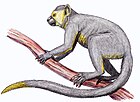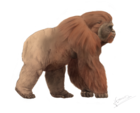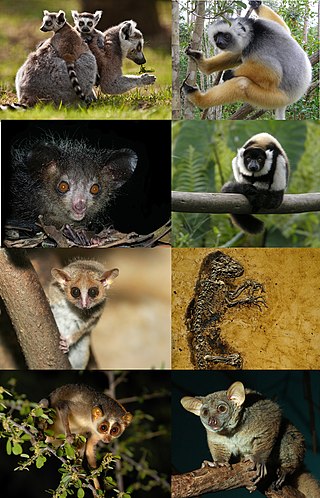
Strepsirrhini or Strepsirhini is a suborder of primates that includes the lemuriform primates, which consist of the lemurs of Madagascar, galagos ("bushbabies") and pottos from Africa, and the lorises from India and southeast Asia. Collectively they are referred to as strepsirrhines. Also belonging to the suborder are the extinct adapiform primates which thrived during the Eocene in Europe, North America, and Asia, but disappeared from most of the Northern Hemisphere as the climate cooled. Adapiforms are sometimes referred to as being "lemur-like", although the diversity of both lemurs and adapiforms does not support this comparison.

Haplorhini, the haplorhines or the "dry-nosed" primates is a suborder of primates containing the tarsiers and the simians, as sister of the Strepsirrhini ("moist-nosed"). The name is sometimes spelled Haplorrhini. The simians include catarrhines, and the platyrrhines.

Omomyidae is a group of early primates that radiated during the Eocene epoch between about 55 to 34 million years ago (mya). Fossil omomyids are found in North America, Europe & Asia, making it one of two groups of Eocene primates with a geographic distribution spanning holarctic continents, the other being the adapids. Early representatives of the Omomyidae and Adapidae appear suddenly at the beginning of the Eocene in North America, Europe, and Asia, and are the earliest known crown primates.

Tarsiiformes are a group of primates that once ranged across Europe, northern Africa, Asia, and North America, but whose extant species are all found in the islands of Southeast Asia. Tarsiers are the only living members of the infraorder; other members of Tarsiidae include the extinct Tarsius eocaenus from the Eocene, and Tarsius thailandicus from the Miocene. Two extinct genera, Xanthorhysis and Afrotarsius, are considered to be close relatives of the living tarsiers, and are generally classified within Tarsiiformes, with the former grouped within family Tarsiidae, and the latter listed as incertae sedis (undefined). Omomyids are generally considered to be extinct relatives, or even ancestors, of the living tarsiers, and are often classified within Tarsiiformes.

The simians, anthropoids, or higher primates are an infraorder of primates containing all animals traditionally called monkeys and apes. More precisely, they consist of the parvorders Platyrrhini and Catarrhini, the latter of which consists of the family Cercopithecidae and the superfamily Hominoidea.

Plesiadapis is one of the oldest known primate-like mammal genera which existed about 58–55 million years ago in North America and Europe. Plesiadapis means "near-Adapis", which is a reference to the adapiform primate of the Eocene period, Adapis. Plesiadapis tricuspidens, the type specimen, is named after the three cusps present on its upper incisors.
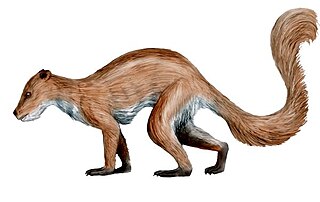
Plesiadapiformes is an extinct basal pan-primates group, as sister to the rest of the pan-primates. The pan-primates together with the Dermoptera form the Primatomorpha. Purgatorius may not be a primate as an extinct sister to the rest of the Dermoptera or a separate, more basal stem pan-primate branch. Even with Purgatorius removed, the crown primates may even have emerged in this group.
Altiatlasius is an extinct genus of mammal, which may have been the oldest known primate, dating to the Late Paleocene from Morocco. The only species, Altiatlasius koulchii, was described in 1990.
Philip Dean Gingerich is an American paleontologist and educator. He is a Professor Emeritus of Geology, Biology, and Anthropology at the University of Michigan, Ann Arbor and directed the Museum of Paleontology at the University of Michigan (UMMP) from 1981-2010. His research focus is on vertebrate paleontology, especially the Paleocene-Eocene transition and early Cenozoic mammals. His primary research focus is on the origin of modern orders of mammals and he is a leading expert on the evolution of primates and whales. Gingerich was among the experts who analyzed the skeleton of Darwinius masillae.
K. Christopher Beard is an American paleontologist, an expert on the primate fossil record and a 2000 MacArthur Fellowship "Genius" Award Winner. Beard's research is reshaping critical debates about the evolutionary origins of mammals, including primates, routinely questioning current thinking about their geographical origins. Dr. Beard is the former Curator of the Carnegie Museum of Natural History, and Mary R. Dawson Chair of Vertebrate Paleontology, at University of Pittsburgh. He is currently Distinguished Foundation Professor, Senior Curator at the University of Kansas. He was co-author with Dan Gebo about an extinct primate from China. Dr. Beard also authored the book The Hunt for the Dawn Monkey: Unearthing the Origins of Monkeys, Apes and Humans. Beard was also part of the research teams that discovered Teilhardina, the earliest primate ever found in North America, and Eosimias, one of the earliest higher primates yet discovered. He worked with NASA to scan a Tyrannosaurus rex skull. Beard received his PhD from the Functional Anatomy and Evolution Program at Johns Hopkins University School of Medicine in 1989.

Anaptomorphinae is a pre-historic group of primates known from Eocene fossils in North America and Europe and later periods of Paleocene Asia, and are a sub-family of omomyids. The anaptomorphines is a paraphyletic group consisting of the two tribes Trogolemurini and Anaptomorphini. Anaptomorphine radiation in Wyoming, one of the most detailed records of changes within populations and between species in the fossil record, has provided remarkable evidence of transitional fossils.
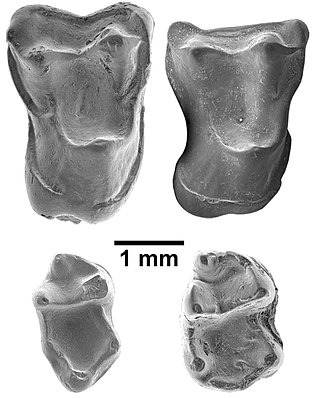
Afrasia djijidae is a fossil primate that lived in Myanmar approximately 37 million years ago, during the late middle Eocene. The only species in the genus Afrasia, it was a small primate, estimated to weigh around 100 grams (3.5 oz). Despite the significant geographic distance between them, Afrasia is thought to be closely related to Afrotarsius, an enigmatic fossil found in Libya and Egypt that dates to 38–39 million years ago. If this relationship is correct, it suggests that early simians dispersed from Asia to Africa during the middle Eocene and would add further support to the hypothesis that the first simians evolved in Asia, not Africa. Neither Afrasia nor Afrotarsius, which together form the family Afrotarsiidae, is considered ancestral to living simians, but they are part of a side branch or stem group known as eosimiiforms. Because they did not give rise to the stem simians that are known from the same deposits in Africa, early Asian simians are thought to have dispersed from Asia to Africa more than once prior to the late middle Eocene. Such dispersals from Asia to Africa also were seen around the same time in other mammalian groups, including hystricognathous rodents and anthracotheres.
This paleomammalogy list records new fossil mammal taxa that were described during the year 2012, as well as notes other significant paleomammalogy discoveries and events which occurred during that year.
The Willwood Formation is a sedimentary sequence deposited during the late Paleocene to early Eocene, or Clarkforkian, Wasatchian and Bridgerian in the NALMA classification.

Archicebus is a genus of fossil primates that lived in the early Eocene forests of what is now Jingzhou in the Hubei Province in central China, discovered in 2003. The only known species, A. achilles, was a small primate, estimated to weigh about 20–30 grams (0.7–1.1 oz), and is the only known member of the family Archicebidae. When discovered, it was the oldest fossil haplorhine primate skeleton found, appearing to be most closely related to tarsiers and the fossil omomyids, although A. achilles is suggested to have been diurnal, whereas tarsiers are nocturnal. Resembling tarsiers and simians, it was a haplorhine primate, and it also may have resembled the last common ancestor of all haplorhines.

The Wasatch Formation (Tw) is an extensive highly fossiliferous geologic formation stretching across several basins in Idaho, Montana, Wyoming, Utah and western Colorado. It preserves fossils dating back to the Early Eocene period. The formation defines the Wasatchian or Lostcabinian, a period of time used within the NALMA classification, but the formation ranges in age from the Clarkforkian to Bridgerian.

The San Jose Formation is an Early Eocene geologic formation in the San Juan Basin of New Mexico and Colorado.

The evolutionary history of the primates can be traced back 57-90 million years. One of the oldest known primate-like mammal species, Plesiadapis, came from North America; another, Archicebus, came from China. Other similar basal primates were widespread in Eurasia and Africa during the tropical conditions of the Paleocene and Eocene. Purgatorius is the genus of the four extinct species believed to be the earliest example of a primate or a proto-primate, a primatomorph precursor to the Plesiadapiformes, dating to as old as 66 million years ago.
Bownomomys was an early marmoset-like primate that lived in North America during the Early Eocene epoch, about 56-50 million years ago.
Palaeohodites is an extinct genus of primate from the Eocene Nadu Formation of China. Living about 35 million years ago during the late Eocene, Palaeohodites belongs to an extinct group of primates known as adapiforms, related to modern day lemurs and lorises. Specifically, this genus is one member of the family Ekgmowechashalidae, known primarily from the Eocene and Oligocene of Asia. Notably, Palaeohodites has been recovered as the sister taxon of Ekgmowechashala, the latest primate known to exist in North America before the arrival of humans at the end of the Pleistocene.















